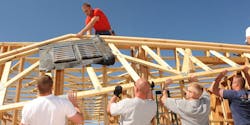The ongoing labor shortage is one of the housing industry’s most pressing issues, but according to a recent poll conducted by NAHB, the industry can expect little relief from young adults entering the labor force .
Results of the poll of 2,001 adults between the ages of 18 and 25 indicate that of the 74 percent of respondents who said they know their desired career field, just 3 percent said they want to work in the construction trades. Young adults indicated that they are more attracted to careers in the medical field (16 percent), management and business sector (12 percent), and technology and IT (9 percent). Careers in government and the performing arts accounted for 3 percent of respondents’ career choices.
In addition, the poll found that 63 percent of undecided young adults said there was little or no chance that they would join the trades, regardless of pay. Nearly half of these respondents said they didn’t want such a physically demanding job, and nearly a third said that construction work is difficult. A quarter said they want an office job.
When undecided adults were asked what annual salary it would take for them to consider the construction trades, 43 percent said they would need to earn $75,000 or more. An equal share said they wouldn’t consider the trades no matter the pay.
These undecided adults may be unaware of the career opportunities that the construction industry provides. Jill Herman, program director for the California Homebuilding Foundation (CHF), says that there are more than 150 jobs involved with the building and selling of just one single-family home. Entry-level tradesmen may start out pounding nails in the hot sun, but they can work their way up to project manager or supervisor, or even own their own company. “Careers in construction can be very diverse, complex, and require a great deal of skill,” Herman points out. “There’s just a really big misconception about what a career in construction actually is.”
Herman directs the CHF’s Building Industry Technology Academy, a four-year construction trades training program that’s active in 21 California high schools. Students learn construction and math skills, work on full-scale projects, and network with builders in the industry.
Schools across the nation have been pushing an academic focus in science, technology, engineering, and mathematics (STEM) for the past decade in an attempt to address the declining competitiveness of the U.S. in these disciplines. Construction technology and training fit these sorts of programs, Herman says. Students can apply this knowledge to the design-build environment and find a niche in construction. “While there is innovation in our industry,” she says, “you still need those skills and that knowledge of how to build a house from the ground up. Those are careers that aren’t going away.”
Bob Kochmann, president of Kochmann Brothers Homes, in Fargo, N.D., says that kids today aren’t exposed to the trades and that they often aren’t used to working with their hands. For many students—and for many parents—the mindset is college or bust. “There’s kind of a stigma in high school,” Kochmann told Professional Builder, “that if you don’t go to college, you don’t quite measure up in society. But that’s a misconception.”
Kochmann is involved with the Herdina Academy for the Construction Trades, a two-week course held during the summer where high school students are taught building techniques, including framing, pouring concrete, installing doors and windows, and surveying. He says that some students can come in totally green and leave the course with a solid appreciation for construction, even for tougher jobs such as roofing.
Rather than accumulating student debt by embarking on a four-year university degree, students can attend a trade school, learn a skill, and enter the workforce sooner. The industry certainly needs them. For the January edition of the NAHB/Wells Fargo Housing Market Index, 78 percent of builders said that the cost and availability of labor was a problem in 2016, and 82 percent said it was an issue they expected to face in 2017. Without an influx of younger workers, homes will take longer to build, the quality of new homes will dip, and prices will rise, Herman cautions.
Kochmann says that the opportunity for young workers is there, as skilled workers continue to age. For example, the average age of plumbers, pipe fitters, and steamfitters is 42 years old, according to 2015 data from NAHB. Some regional estimates put the average age of a plumber as high as 55.
“We are going to have one heck of a shortage coming up,” Kochmann says. “Plumbers are pretty much going to be able to dictate what they’re worth.”
